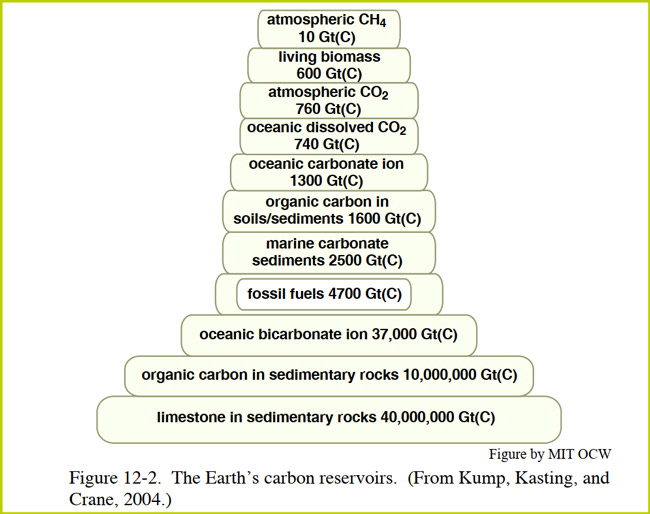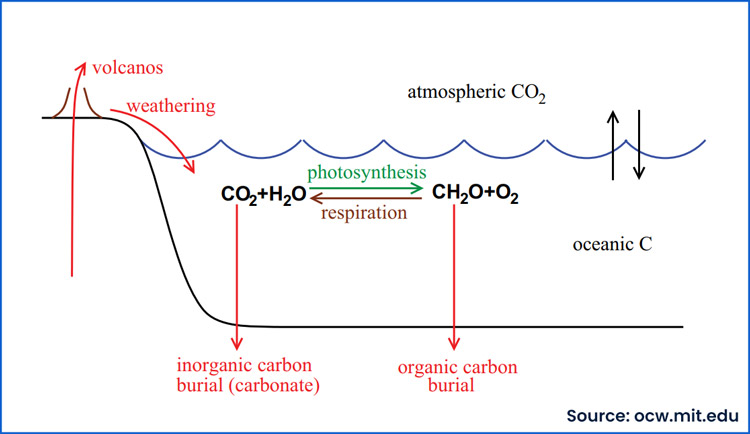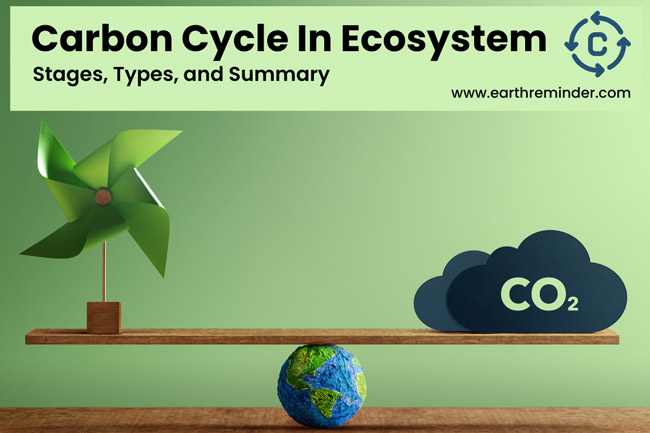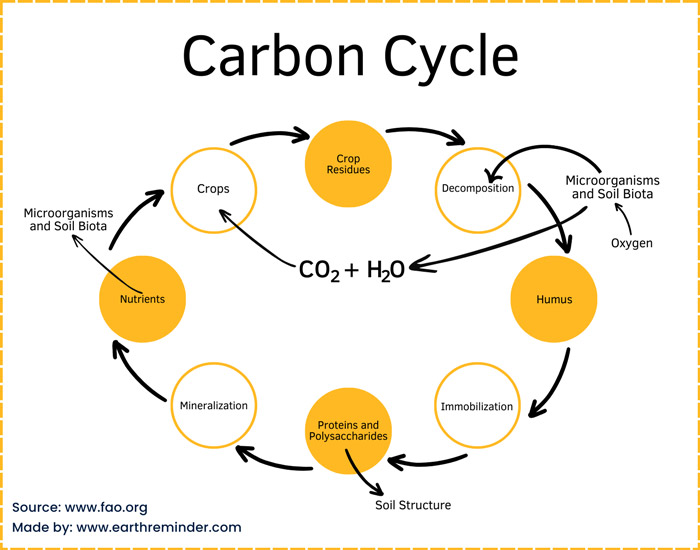Carbon Cycle In Ecosystem: Stages, Types, and Summary
In our Earth’s ecosystem, the Carbon Cycle plays a huge role in balancing the environment. Plants, animals, air, and soil all contain carbon, which makes our life possible. Our environment is a complex web of life, and understanding the carbon cycle in an ecosystem is really important. Here, we’ll discuss what the carbon cycle is, then study different stages and types of it, and finally sum it up.
Table of Contents
Introduction Of Carbon Cycle
The carbon cycle is one of the most crucial biogeological cycles. Like water, nitrogen, and other elements, carbon transfers from one structure to another, forming a cycle. Moreover, understanding the carbon cycle in the ecosystem is critical to saving our planet from the ongoing environmental issues. This is because carbon is involved in various compounds (both organic and inorganic), and its study requires us to understand three distinct scientific aspects: biology, geology, and climatology.
Carbon is said to be the fourth most available element on the earth. We are made up of carbons; the plants, the animals, and most of the things we see in our regular lives consist of carbon compounds. And often, it’s the central element when we discuss all the climate issues.
Rocks are the primary storage house for carbons (65,500 billion metric tons). Besides, these are available both at the earth’s surface and deep inside it due to various processes.
Another name for carbon is life. It forms several elements through covalent bonds, and we can see various cyclic and long-chain forms (like DNA) of carbon inside living beings.
All living things contain carbon, and without it, life on earth could be barely possible. This is because all biological cycles require carbon to function.
And the study of the presence of carbon in different forms and its transfer from distinct organic and inorganic elements is defined as the carbon cycle.
Before diving deeper into the different types (or components) of the carbon cycle, we must understand the overall mechanism.
Stages of Carbon Cycle
If we discuss the carbon cycle in general in the ecosystem, it has three distinctive stages: absorption of carbon, release of carbon (respiration, decomposition, combustion, volcanism), and storage of carbon. Let’s discuss it in detail below:
Stage-1: Absorption of Carbon
The plants and phytoplankton present in the land and oceans absorb the carbon molecule and convert it into sugar and oxygen. We study this process as photosynthesis. They use sunlight to convert atmospheric carbon dioxide into organic matter.
Stage-2: Release of Carbon
A large quantity of carbon returns to the atmosphere, primarily as carbon dioxide. And its quantity is about 0.4% by volume. However, small fractions of CH4 – about 1.7 x 10-4 – also keep on in the atmosphere.
Now the question arises, how does carbon come into the atmosphere? There are various processes involved through which carbon fluxes into the surrounding.
Respiration of Organisms:
All living organisms conduct respiration to obtain energy from the food they eat. During the respiration process, the cell absorbs the oxygen to break down the macromolecules (carbohydrates, proteins, and lipids) mostly, sugar (glucose and its derivatives).
As a result, carbon dioxide, water, and energy are released from the cells. This carbon dioxide transfers from one form to another inside a living body or vents outside the atmosphere.
Note that respiration and photosynthesis are quite the opposite processes. Hence, they form a carbon cycle itself.
Decomposition of Organic Materials:
And when the animals or plants die or decay, the microorganisms present in the soil consume them as food and decompose them into different other organic and inorganic materials. Here also, CO2 is released and mixes up in the air.
Combustion Of Plant Materials and Fossil Fuels:
Also, the plant materials are either burned naturally through lightning or combust artificially as biomass. Similarly, we burn fossil fuels to release CO2 into the ecosystem.

Volcanism:
Also, sometimes the stored carbon deep inside the earth comes back to the atmosphere in lava through volcanic eruptions.
Stage-3: Burry or Storage of Carbon
The process called weathering brings the stored carbon in the rocks and stones back to the oceans. According to www.pbs.org, carbon is stored in the ocean 50 times more than in the atmosphere, as well as 20 times more than in the soil and plants on land.
And it is released back to the surface through volcanism. This forms an entire cycle involving all three components: biological, geological, and climatic.
Types Of Carbon Cycle
There are two major types of the carbon cycle, i.e. biogeological cycle and the geological cycle. Below we will discuss them in more detail:
Biological Carbon Cycle
The biological carbon cycle occurs through the involvement of living beings. It starts from the autotrophs with the process called photosynthesis and ends after the release of the carbon back to the atmosphere. Let us understand it deeply.
All the autotrophs receive sunlight as energy and absorb the atmospheric carbon dioxide and moisture from the soil to form food materials like glucose and oxygen.
You can visualize the reaction as shown below;
CO2 + H2O + Sunlight (energy) ↔ CH2O (sugar molecule) + O2
All living organisms receive the oxygen released from the photosynthesis process to perform respiration. CO2 and water are released from the organic materials as the byproduct and ATP as energy during this process.
The heterotrophs, both carnivores, and omnivores, also derive food materials from the other heterotrophs. And in this way, the molecules revolve from one living being to another, forming a biological cycle itself.
Ultimately, the CO2 exudes from the body to mix up with other gases in the atmosphere.
Furthermore, after death and decay, the living components (carbon) get decomposed by the microorganisms and converted into various organic matter that eventually gets back to the atmosphere as CO2.
Geological Carbon Cycle
The geological or geochemical carbon cycle occurs through different geological components such as rock, soil, air, and water.

When mixed with rainwater, the atmospheric carbon forms carbonate ions. And when the carbonic acid (carbonate + hydrogen) comes down to earth, it breaks the stones – the largest storage house of carbon. This process of deterioration of rocks is termed weathering (chemical weathering).
Due to some climatic factors, the carbon, along with the calcium, magnesium, sodium, and potassium residues by soil erosion, flows to the water reservoirs and finally reaches the oceans.
Either the autotrophs absorb this carbon for photosynthesis, or it dumps at the bottom part of the ocean. And after gradual deposition for millions of years, these carbons form mineral limes such as calcite, dolomite, and aragonite. That eventually includes carbonate rocks such as limestone and dolostone.
Deep inside the ocean, corals and phytoplankton-like organisms live. These organisms calcify and form shells. After their death and degradation and years of deposition, that lime also gets converted into rocks.
Some dead and decaying organic matter within mud forms about 20% of organic rocks – shale.
However, under the soil, there are tectonic plates. Some environmental factors cause these plates to displace from their place, creating some voids. This causes the mineral stones to bury under the soil. And that embedded minerals and carbon again came back to the surface through the volcanic eruption.
Carbon Cycle in Different Ecosystems
We can further divide the carbon cycle based on the types of ecosystems. Let’s study these briefly.
Carbon Cycle in Forest and Grassland Ecosystem
The carbon cycle in forest and grassland ecosystems is quite similar. We can easily understand this by referring to the biological carbon cycle.
In a forest or grassland ecosystem, the autotrophs produce food materials through photosynthesis. Herbivore animals consume these food materials as a source of energy. The carnivores then take the food from the herbivores, and the carbon moves between this food chain.
Also, human beings and other omnivore animals derive food from herbivores and autotrophs.
Various organisms take the carbon in the grassland and forest ecosystem now released back to the atmosphere by respiration, forming a carbon cycle.
Also, after the death of these living beings, some microorganisms decompose and then transfer the carbon residues to various simple organic materials.
The carbon also fluxes from the soil in the grassland and forest ecosystem.
Various soil organisms, after the conversion, consume the carbon for their growth and respire to release it into the air. Further, roots (of autotrophs) inside the soil perform cellular respiration to remove the waste carbon dioxide into the ground.
Carbon Cycle in Aquatic Ecosystem
The carbon cycle in the aquatic ecosystem began with the hydrologic cycle and combined with the rock cycle to finally evaporate the CO2 back to the atmosphere.
Slow and Fast Carbon Cycles
The transfer of carbon through the rock cycle takes millions of years. Therefore, it is known as the slow carbon cycle.
Besides the mineral rocks, we can also see the slow carbon cycle between the soil and atmosphere. After years of burying under the earth, the dead living matter with enormous heat and pressure becomes fossil fuels: coal, natural gas, and petroleum.
We human beings extract these and burn them as fuels. After the combustion of these fossil fuels, it again releases into the atmosphere.
Through the slow carbon cycle, about 10 to 100 million metric tons of carbon moves every year.
We can consider the biological carbon cycle as the fast carbon cycle.
Throughout the plant lifespan, we can measure the net gain and loss of carbon, which occurs faster than the carbon cycle through the geological components (rock cycle).
The cycling of carbon through living organisms is quite fast. Hence, we can call it the Fast carbon cycle.
Through this process, about 1016 to 1017 grams of carbon get transferred throughout the cycle each year.
Here we can determine the rate of carbon transfer through the increase and decrease of carbon in the atmosphere throughout the growth and decay cycle.
Impact Of Humans on Carbon Cycle
Due to various human interventions, the net carbon flux in the atmosphere is rapidly increasing. And we can measure this in the form of carbon footprints.
The burning of fossil fuels, chopping down trees, and other anthropogenic causes are disbalancing the carbon cycle.
As a result, we can easily see environmental issues such as global warming, climate change, acid rain, melting of glaciers, etc.
Without consciousness, our earth can barely reach its natural state. Thus, studying the carbon cycle in different ecosystems is highly crucial.
Summary Of the Carbon Cycle
You might get confused about the different steps involved in the carbon cycle. So, let’s recap the major points:
- At first, the atmospheric carbon (in the form of CO2 and CH4) gets absorbed by the autotrophs – plants and phytoplankton – by photosynthesis.
- Here they form sugar (glucose and its derivatives) as the food material and oxygen as a byproduct.
- All the animals (including us) consume that food produced by plants to gain energy and to perform all other mechanisms in their body.
- We accept the oxygen in the atmosphere during respiration, break down the food materials to ATP (as energy), and release CO2 and water to the atmosphere.
- This forms a cycle itself that occurs inside the living beings.
- After the death and decay of living beings, the microbes present in the soil and atmosphere absorb the accumulated carbon from their body and decompose those materials into simple organic and inorganic matters.
- Some soil organisms readily take these materials for living, or the carbon in the form of CO2 exudes to the air.
- Also, carbon dioxide comes into the atmosphere through biomass and fossil fuels combustion.
- Sometimes, the atmospheric carbon mixes with rainwater to form carbonic acid (weak acid) and fall back to the earth, deteriorating the rocks and other calcified structures. This process is called weathering.
- Now the weathered carbon (and other minerals) along with the carbon present in the soil through erosion mixes with the large water bodies (oceans).
- These minerals and carbon (carbonates) get accumulated and stored for millions of years to form rocks and stones inside the oceans.
- Some other calcifying organisms like corals also participate in rock formation after their death.
- The mud-embedded plant and animal materials form shale when deposited for years.
- The tectonic plates are present in the crust through various climatic factors; when they get displaced, these stored rocks get buried inside the earth.
- Carbon in these buried rocks comes back to earth through volcanism (volcanic eruption). And the cycle repeats.
- When the carbon from living bodies is buried faster than the rock formation, millions of years of pressure and heat convert them into different fossil fuels like coal, petroleum, and natural gases.
- We extract these fossil fuels and burn them to produce electricity.
As we can see above, the carbon cycle plays a big role in our ecosystem. Through its multiple stages, it controls atmospheric carbon levels and helps us understand how everything is connected. If we want to protect our environment for future generations, we have to recognize this valuable process.

